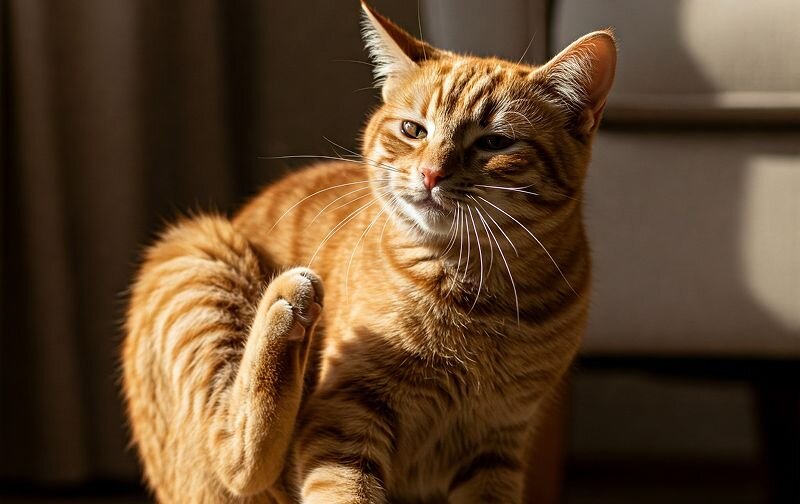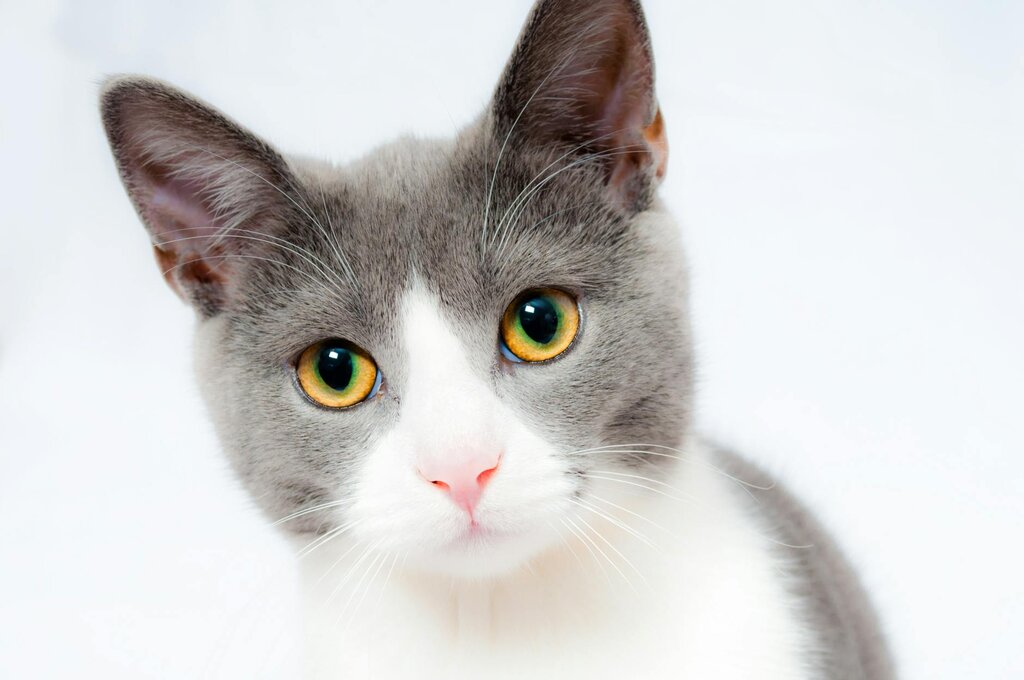Last Updated: 13/05/2025
Cat Dandruff
Does your cat have unsightly and troublesome dandruff? Take a read through our Vet-guide on the causes diagnosis and treatment of dandruff in cats.
Author: Dr Katelyn Bailey BVSc (Hons)
Reading Time: 23 minutes - medium read
Cats, like humans, can also be affected by unsightly and bothersome dandruff. While it's usually easy to see that your cat has dandruff, discovering why they have it may not be as simple. Read on to find out more about this condition, what causes it, and how it can be managed.
What is dandruff?

Dandruff refers to an abnormal or excessive shedding of epidermal (skin) cells. Other names for the condition include flakes, scales, scurf and seborrhoea. Dandruff has many causes, which all affect the skin's normal exfoliation process or life cycle in certain ways. This results in increased flaking. In cats, the 'dry' form is more common, but 'oily' or combination forms of the condition are also seen.
Dandruff is not to be confused with dander. While dandruff is abnormal and only experienced by some cats, dander is completely normal and shed by all cats. The term 'dander' refers to microscopic pieces of skin cells that cats shed into their surrounding environment. Dander contains an allergen which has been linked to allergic responses in some humans. Dandruff may contain dander, but eliminating dandruff will not get rid of dander.
How to know if your cat has dandruff
In most cases, dandruff is easily visible on your cat's coat or bedding as pale coloured flakes. This may be the only abnormality, or your kitty may also experience any of the following accompanying signs:
- Itching
- Dry or oily skin or coat
- Red, irritated skin
- Hair loss
- Change in grooming habits
- Lethargy
If your cat is showing any of these signs in addition to dandruff, or if the dandruff is quite severe, they should be examined by a veterinarian to check for underlying causes.
Causes of dandruff in cats
In the majority of cases, dandruff occurs due to environmental factors or secondary to an underlying skin, nutritional, age-related or hormonal condition. Via various mechanisms these underlying conditions interfere with the normal life cycle of skin cells, or cause irritation to the skin.
Dandruff can occur due to the following:
Poor nutrition: Poor quality diets are a common culprit, as well as diets lacking in omega fatty acids or vitamin A - both of these compounds are vital contributors to overall skin health.
Allergies: Flea allergy dermatitis, food allergies, contact allergies and airborne allergies can all cause itching and/or overgrooming, which traumatises skin cells and causes dandruff. To learn more, take a look at the Common Causes of Itching in Cats.
Parasites: Ringworm, mites and lice can all cause dry flaky skin, itching, and dandruff.
Poor grooming: If a cat is unable to groom themselves properly, for example due to age, pain, arthritis or obesity, dry skin and dandruff may become apparent. In these cases, tricky to reach areas like the lower back and base of the tail tend to be most affected.
Age: Older animals can experience age-related changes to the life cycle of their skin cells, which may naturally predispose them to dandruff.
Environmental conditions: Both low humidity and excessive heating can cause dry skin, irritation and flaking.
Hormonal disorders: Hormonal disorders such as hyperthyroidism or diabetes affect the quality of the coat and may also alter grooming habits.
Other rarer skin conditions including autoimmune diseases such as pemphigus or lupus can cause dandruff.
Much less commonly, dandruff occurs due to a primary disorder, rather than secondary to another condition. Primary disorders are rare, often have a genetic basis, and tend to become apparent by the time the cat is 2 years of age. These causes are generally a diagnosis of exclusion, which means all other possibilities first need to be ruled out. One example is primary seborrhoea which is a genetic condition that Persian cats are predisposed to.
Diagnosis of dandruff in cats

While it's often easy to tell that your cat has dandruff, what's causing the flaking in the first place can be trickier to figure out.
Your vet will start by collecting a thorough history from you regarding the timeframe of the problem, any accompanying signs and your cat's current environment and parasite prevention regime.
They may perform a range of diagnostic tests including:
- Skin scrape to check for parasites
- Wood's lamp test or culture to screen for ringworm
- Skin cytology to check for infection
- Hair pluck exam to examine hair follicles
- Skin biopsy to assess affected layers of skin at a microscopic level
- Blood testing to check for organ dysfunction, inflammatory disorder or hormonal disorderIntradermal allergy test if allergies suspected
- Hypoallergenic food trial if food allergy suspected
In complex cases your veterinarian may refer you to a veterinary dermatologist or internal medicine specialist.
Treatment of dandruff in cats
If the underlying cause is found, treatment or management can then be commenced. Once the primary disease is under controI, the dandruff often settles without direct treatment. If this does not occur, then ongoing management of the problem may be required.
Below are some general methods that can help to reduce dandruff. It's important to always follow your treating veterinarian's advice regarding the best management option for your cat.
Prevention of dandruff in cats
While some causes of dandruff unfortunately cannot be prevented, there are a few things you can do to reduce the chance that your cat will develop the condition. A great place to start is by making sure your feline friend is not exposed to the most common risk factors.
- Keep your cat up to date with parasite prevention: Even indoor cats can be exposed to itchy parasites like fleas and mites, so it's vital to always make sure your kitty is up to date with their preventatives. You can read more about this in our Flea, Tick and Worming Guide for cats.
- Feed a premium, complete and balanced diet: The process of renewing skin cells uses a decent percentage of your cat's daily protein intake so any food they eat should include high quality, highly digestible proteins that are easily absorbed into their system. Premium diets are superior in quality to supermarket brands. Premium brands include Royal Canin, Advance, Hills and Pro Plan.
- Maintain your cat at a healthy weight: Overweight cats find it difficult to groom themselves particularly in hard to reach areas like the base of the tail, and their coat quality can also suffer. Keep an eye on your cat's body condition score, and look into a premium weight control diet if they're looking a little pudgy.
- Manage arthritis effectively: Along with dandruff and a dirty or matted coat, other signs of arthritis include stiffness, reluctance to jump, reduced activity and behaviour changes. Regular grooming, environmental modifications and effective management of arthritic pain are recommended once arthritis has been identified.
- Alter the environment: If your cat is exposed to regular dry heating or environments with low humidity, investing in a humidifier and placing this in the room where your cat spends most of their time can help to prevent dry skin and dandruff.
- Encourage good hydration: Moisture is essential for a healthy coat and skin so encouraging water intake in the form of wet food and/or a water fountain will help to ensure your kitty is nice and hydrated. Good hydration has the added benefit of promoting a healthy urinary tract.
Further Reading
Want to read more? Check out our other articles:
History
Our experts continually monitor the health and wellness space and we update our articles when new information becomes available.
Wed Jan 11 2023
Written by Dr Katelyn Bailey BVSc (Hons)Dr Katelyn Bailey BVSc (Hons)
Veterinarian
Dr Katelyn Bailey graduated as a veterinarian from The University of Queensland in 2018 and has since worked in small animal general practice clinics in south-east Queensland. Her special interests include feline medicine and behaviour, preventative health care, internal medicine, research and senior pet care. Katelyn is a strong proponent of the human-animal bond and loves to hear about the quirks that make each pet so special.

